The food of Beijing ranges from spectacular imperial dishes to comforting home-style dishes. In this ancient capital you can absolutely fond some tasty local dishes. Below are 10 kinds of food that you should have a try in Beijing.
1. Peking Duck (or Peking Roasted Duck, 北京烤鸭)
This is an easy one. Far and beyond the best food from Beijing that you absolutely have to try is Beijing Roast Duck. In Beijing there are a few 100+ year old restaurants and chains that serve this delicious delicacy to perfection. The skin should be crispy while the meat should remain juicy and succulent. Take the wrap, put some bean sauce, cucumber and spring onions inside and top it off with a slice or two of duck.
Chinese: 北京烤鸭 běijīng kǎoyā /bay-jing kaow-yaa/)
Restaurant recommendation: Da Dong Duck Restaurant (大董烤鸭)
Address: F1-F2, Nanxincang Business Building, 22 Dongsitiao Jia, Dongcheng District 东城区东四十条甲22号南新仓商务大厦1-2楼
Price: CNY198 for a whole duck (will feed three/four)
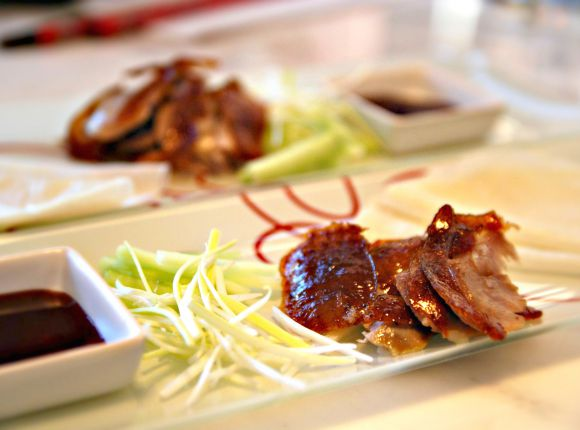
2. Shao Mai Dumplings (烧卖)
Shao Mai are steam-cooked dumplings with a statement. Contrary to other traditional Chinese dumplings, these are left open at the top so you could actually see what's inside. Usually it's pork, but beef, mutton and crab can also be found, as well as shrimp, mushrooms, bamboo shoots, chives and onions. Yummy!!! Make sure to have it with a dipping sauce – soy, chile, or hot mustard – if you find a proper place to order it. There aren't many restaurants in Beijing left to sell Shao Mai these days. Reputedly, the best one still in operation for traditional Beijing Shao Mai is the Du Yi Chu Shaomai Restaurant. Hurry while you can!
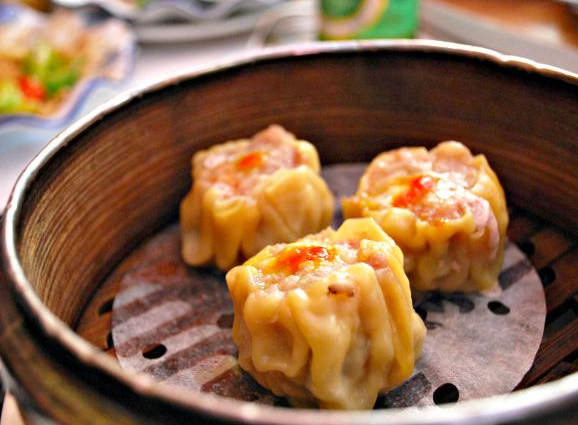
3. Stir Fried Pork Liver 炒肝儿
Liver fans rejoice, this Beijing dish is the king of Chinese Liver dishes. Oddly enough this dish is served for breakfast and is sipped straight from the bowl, only using the spoon to fish out the bigger liver and intestine pieces. The thick soup is made of bone stock and mushroom broth. Raw garlic is added to make it even more savory.

4. Zhájiàng noodles (炸酱面, Zhájiàngmiàn)
Zhajiang Mian, or Fried Sauce Noodles, are thick, hand-pulled wheat noodles topped with Zhajiang sauce, cucumbers, sprouts and soybeans. The sauce is made by simmering stir-fried ground pork with soybean paste. The richness of ingredients brings out the sweet and savory flavors of the sauce that perfectly compliment the noodles.
Chinese: 炸酱面 (zhá jiàng miàn /jaa-jyang myen/)
Restaurant recommendation: Old Beijing Zhajiang Noodle King (老北京炸酱面大王)
Address: 56 Dong Xinglongjie, Dongcheng District 东城区东兴隆街56号
Price: CNY15
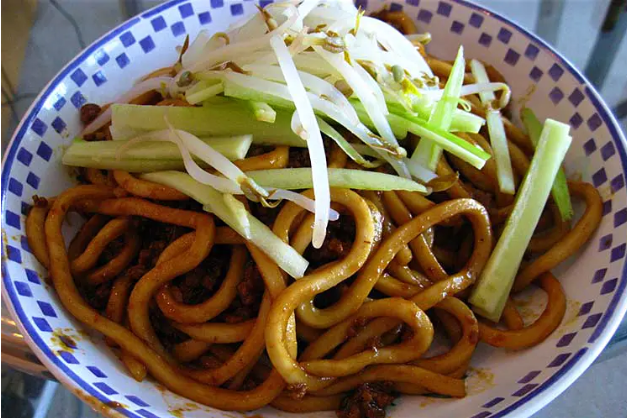
5. Jianbing (煎饼)
This Chinese Crepe 煎饼果子Jiānbing guǒzi is a fantastic breakfast cheap eat that will cost you under USD$1. It’s a delicious Chinese breakfast burrito made with a thin dough spread over a flat, circular griddle. Egg, cilantro, mustard pickles, fried dough and sweet hoisin sauce are then added to create a breakfast that is the perfect balance of soft and crunchy, sweet and savory. It’s important to eat it when it’s hot and fresh off the grill so that the “pancake” stays soft and fluffy and doesn’t get stiff.
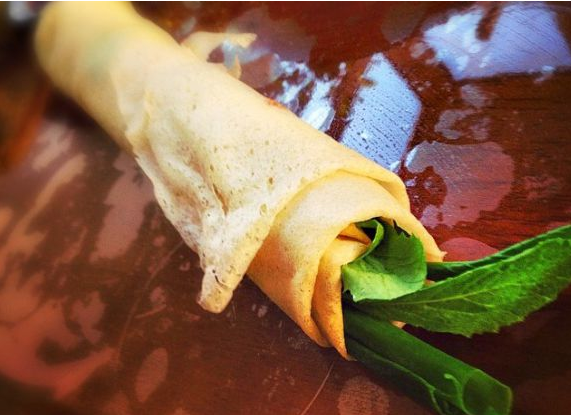
6. Hot Pot (Huo guo, 火鍋)
Those of you DIY fans will love this! In essence, this dish represents paper-thin slices of mutton or lamb cooked instantly in boiling water. For that purpose, in restaurants they put hot-pot right in the middle of the table, so that eaters could cook for themselves. The sliced meat is dropped into boiling water for just a few seconds and then, as soon as it changes color, quickly taken out. Other than meat, into the pot go tofu, vegetables, bean vermicelli, and some other ingredients. To spice it all up, they use a mixture of sesame sauce, leek flower, ginger, chili oil, and some other peculiar stuff.
Chinese: 蒙古火锅 (Ménggǔ huǒguō /mnng-goo hwor-gwor/)
Restaurant recommendation: Dong Lai Shun (东来顺)
Address: 12 Xinyuanxili Zhongjie, Chaoyang District 朝阳区新源西里中街12号
Price: CNY 90/person (for an entire meal)
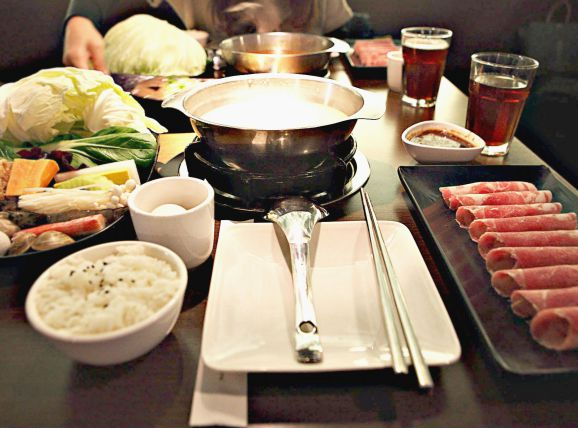
7. Mung Bean Milk (Dou Zhi, 豆汁)
Okay so admittedly this first breakfast on the list is a tough sell. But true Beijingers love Douzhi so it has to make the list. Similar to soymilk, this fermented meng bean milk is the by-product of cellophane noodle production. The color is greyish and the aroma is of rotten eggs, but the sour taste is something that old-school Beijingers pine for, so it must be good after 2–3 tastes.
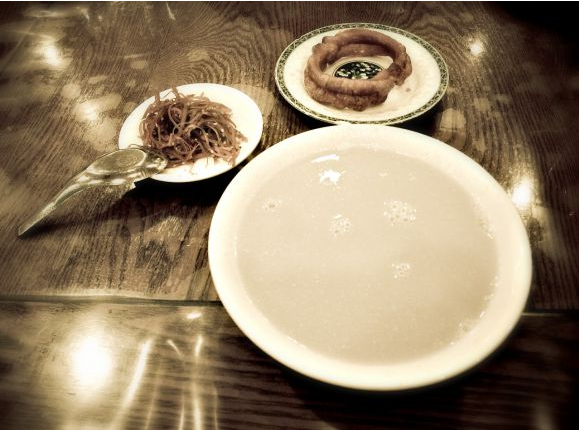
8. Peking Pork (Jing Du Pai Gu, 京都排骨)
Jingjiang rousi is another culinary delight adored by Beijingers and, most notably, one of the few local food hits originated here in the capital. In large part, it owes popularity to its simplicity. In essence, this is just sliced pork cooked in a sweet bean sauce and served with soya bean wraps. Not particularly impressive in appearance, once you have a bite of it, you will know where all the appeal comes from. So, if you're in Beijing and dig on swine, go give it a try! You won't regret!
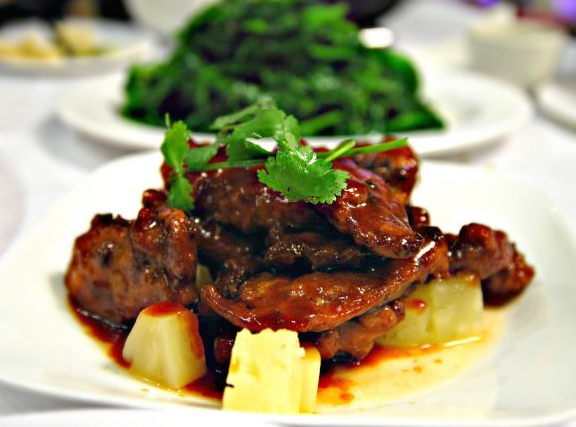
9. Rolling Donkey
Donkey Rolls are a popular Beijing snack or dessert. They are gluntinous rice cakes with sweet red bean paste on the inside rolled in soybean powder. Similar to Japanese mochi, Donkey Rolls are chewy and heavy. The gluntinous rice is mostly unassuming, but the red bean paste and soybean powder add sweet flavor and texture to the cake.
Chinese: 驴打滚 (lǘ dǎgǔn /lyoo daa-gwnn/)
Restaurant recommendation: Bai Ji Niangao (白记年糕)
Address: 1/F, Niu Jie Qingzhen Supermarket, 1 Shangye Lou, Niu Jie, Xuanwu District 宣武区牛街(北口西侧)1号商业楼牛街清真超市1楼
Price: CNY 5–20
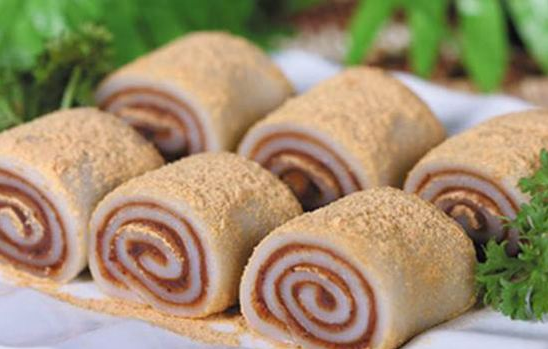
10. Pea Flour Cake (Wan dou huang, 豌豆黄)
In warm time of year (spring or summer), Beijingers develop appetite for a pea flour cake. When everything is melting outside in scorching heat, they melt this thing in their mouth to refresh themselves.The cake is made of white-pea flour and has a distinct bright yellow color with a mild sweet taste.Together with kidney bean cakes and small corn buns, it makes up the top three desserts ever enjoyed by Chinese emperors in the ancient times. Pea flour cake is also eaten on a special occasion, the third day of March, as per the Chinese calendar.

